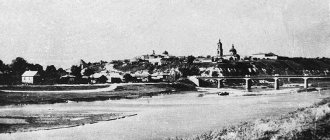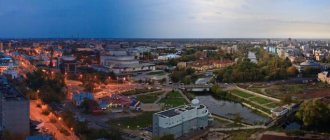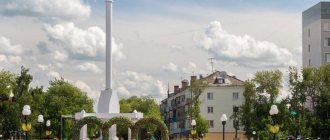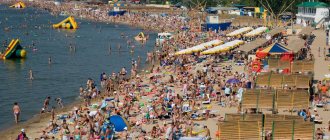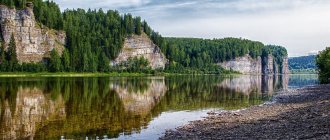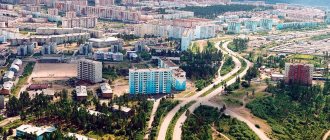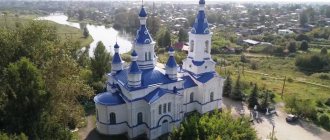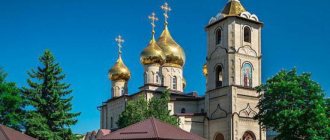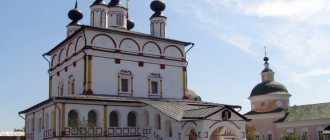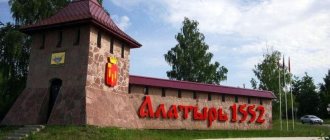Ivanovo – young, cozy city of the Golden Ring of Russia, endowed with a large number of attractions and architectural monuments. The longest electrified railway runs through the territory. It is used to service the Ivanovo silicate plant.
The developing industrial center is famous for its textiles. In Russia, Ivanovo is considered brides because Textile factories used to employ a large number of women.
And theatrical art has been valued here for a long time; performances by Gogol and Ostrovsky were performed here for the first time.
In total, there are twelve textile factories and factories on the territory. The materials used are cotton, wool, chintz, and silk. Popular enterprises include Melange, the Samoilov plant, the New Ivanovskaya Manufactory, and the Ivanovo Worsted Plant, as the only parachute factory in Russia. The settlement is decorated with bridges - Sokovsky, Banny, Prikazny.
Data by year
In 1871, when Ivanovo-Voznesenk received city status, 20,000 people lived in it. It grew quite quickly and in 1897 the number of residents was already 54,200, in 1914 - 146,000, and in 1917 - 174,400. The Civil War led to a sharp reduction in the number of city residents. In 1923 it was only 71,800 people. Pre-revolutionary indicators were achieved and surpassed only in the late 20s and early 30s. In 1931, statistics showed that 177,200 people lived in Ivanovo.
The policy of industrialization gave a new powerful impetus to the growth of the Ivanovo population. In 1939, its population was 285,182 people. Subsequently, this figure grew steadily. In 1956 it was 319,000, 1979 - 464,526, 1991 - 48,200.
The structural crisis of the 90s, associated with the destruction of the economy and social sphere of our country, led to a sharp deterioration in demographics in the city of Ivanovo. In dynamics, information about the number of its inhabitants looks like this:
- 1992 - 480,000 people.
- 1998 — 464000.
- 2001 — 452100.
- 2009 — 404539.
Then there was some stabilization. In 2011, the number of residents in the regional center was 409,300. But this did not lead to a radical improvement in the situation and further demographic decline continued. According to current information, the number of residents as of 2016 was 408,025, and in 2022 it is already 404,598. According to this parameter, the Ivanovo urban district ranks 49th in the Russian Federation.
House-ship
House-ship
Ivanovo
As Vladimir Mayakovsky wrote in the twenties: “Moscow and Ivanovo... were built anew.”
An example of Soviet constructivism, this house is an integral symbol of Ivanovo. Architect Friedman turned a residential building for workers into a floating ship. One of the ends is shaped like the bow of a ship, and at the “stern” there is an observation tower.
About the city
At the beginning of its history, Ivanovo was a settlement. This is how unfortified rural settlements are designated in archeology. The first written mention of the village dates back to 1608. During the Time of Troubles, it was captured by Polish invaders and was severely devastated. But it was restored quite quickly. Due to low soil fertility, farming was not a profitable activity here, and soon crafts, including textiles, became the main occupation of local residents.
At the end of the 17th century, the village was a famous center of Russian weaving. In the middle of the 18th century, the first manufactories appeared here. This is what science calls industrial enterprises with manual labor, but in which there is already specialization between workers. They were founded by capitalist peasants (entrepreneurs who came from the peasant class).
In 1853, Voznesensky Posad appeared nearby. In 1871 it merged with the village of Ivanovo, as a result of which the city of Ivanovo-Voznesensk arose, which immediately became one of the main centers of the textile industry of the Russian Empire. In 1932 the city received its modern name.
During Soviet times, the city remained the largest center of domestic and global textile production. At the same time, a number of large mechanical engineering plants were built. By the way, it was largely thanks to textile production that Ivanovo received its nickname “the city of brides.” After all, weaving work was traditionally female work and many young girls worked in Ivanovo factories.
Attractions
In one day you are unlikely to be able to thoroughly explore all the surroundings, since there are many places for entertainment and cultural heritage. But if you plan your route wisely, you will be able to visit the most popular tourist spots, having a great rest and expanding your horizons.
Churches and cathedrals
Compared to other cities, there are much fewer monasteries here. Start your tour at the Cathedral of the Assumption of the Blessed Virgin Mary . The shrine appeared about 180 years ago. It was built in 1834. The construction was carried out according to the design of the architect E.Ya. Petrova. These were mainly funds from local manufacturers. The style of construction is late classicism.
The Kazan Church is located on the banks of the Uvodi. In its place there was once a calico-printing factory. It was led by Christian Liman. Mikhail Ivanovich Yamanovsky, as the head of the Old Believers community, having received ownership of the building, decided to build a church. The object, as conceived by the architect Maricelli, was distinguished by its laconic beauty and grandeur.
The Transfiguration Cathedral was founded in 1889. The construction process dragged on for four years. The budget of the manufacturer M.N. Garelin was used. The building is characterized by rich decoration. On the facades you can see kokoshniks and turrets. The octagon is equipped with five chapters, and the windows have elegant platbands. A tented bell tower is installed in the west. There are three entrances with porches.
The Temple of Elijah the Prophet has a close relationship with the history of the city. Once upon a time there was Ilyinskaya Sloboda near the village. The merchant Alexander Lepetov, well-known at that time, donated funds for the construction of the shrine. The building is designed in the style of Russian classicism. Porticoes with four columns are installed on the north and south. The bell tower is visible from the west.
The Church of the Icon of the Mother of God “Joy of All Who Sorrow” was built in 1821. At that time, the Shuya merchant Kornoukhov bought the territory from Count Vorontsov. Dmitrievskaya Sloboda appeared in this place. It bordered on Voznesenskaya, the sides were separated by a river.
The Church of the Vladimir Icon of the Mother of God is one of the main decorations of the city. The Ascension Convent, established here earlier, was considered the value of the Korin and Shcherbakov family. On the outskirts of the property there was the Alekseevskaya women's almshouse. On April 21, 1902, the first stone was laid for the Church of the Vladimir Icon. In 1904 the main altar was illuminated.
The Holy Vedensky Convent is a building in the neo-Byzantine style, considered the hallmark and pearl of the city. It delights with the unusual design. The monastery appeared in the 1990s. The number of nuns is 150 women. It also bears another name “Red Temple” because of the red brick as the main material. Pilgrims come here and excursions are held here.
Museums, monuments, architecture
Perhaps one of the most remarkable objects is the mysterious house-ship , made in the style of constructivism. The house amazes with its unusualness. It was built according to the design of D. Friedman. The architectural features combine two styles - symbolism and romanticism.
It's hard to pass by the horseshoe house . Hundreds of tourists stop here to take a couple of original photographs. The perspective from above is especially unusual. This was once a residential building. Employees of the state political department lived here. It was built in the 1930s. A distinctive feature is the original shape of a semicircle, which resembles a horseshoe. The customer wanted the building to be miniature and compact. As a result, today there is a spectacular building with six floors on the street, which is difficult to pass by without attention. The first floor is used for a store.
The Collective House is another object that is definitely worth a look. An interesting monument of constructivism consists of several buildings. This is a federal level landmark. Development of the project began back in 1920. We tried to implement the project of a communal house. The building is located on Fairgrounds. The buildings are connected to each other by retail space and other buildings. Initially, there was an idea for a corridor system. But then they decided to divide the space into sections. Each building is landscaped. All parts have a different number of floors. There is a cozy courtyard.
The art museum was only in plans for a long time. Military and revolutionary incidents delayed the start of construction. In the 1960s The long-awaited foundation of the exhibition center took place. The authorities found funds for the implementation of the project from the fund. The museum is located on Lenin Avenue 33.
There is a monument to the fighters of the revolution in the city. It is located in the square and was once considered the central attraction. The obelisk was installed in the 1970s. The design causes controversial views among residents. The monument consists of two elements. The central area has a triangular shape, symbolizing the prison casemates.
The Ivanovo Calico Museum is definitely worth a visit, because the entire history of the textile industry is closely intertwined with this place. Calico manufacturing is an important area of the industry. The exhibition was founded in the 1980s. The exhibitions feature antique and modern items. The guide will reveal the secret of the craftsmen’s work. The first exhibits were donated by D. Burylin. Gradually the exhibition began to expand and gained popularity.
The museum is organized in the native mansion of the famous collector. The building itself attracts the eye with its unusual architecture. The façade is elegant and has stained glass windows. This is how many rich houses of the 19th and 20th centuries were decorated. Walking through the halls, you will see Ivanovo calicoes, interesting ornaments, and get closer to the applied arts.
There is even an entire exhibition dedicated to Vyacheslav Zaitsev. The popular fashion designer was born in Ivanovo. By the way, if you use the pedestrian crossing, you will find yourself at another exhibition of industry and art. It is literally a few steps away.
The Museum of the First Fireworks will tell about the first council of workers' deputies in Russia. Once upon a time there was a town council in this building. It was built around 1904. Before this period, there was another ancient wooden building here. It was later changed to brick. In 1980, an exhibition was placed here. The object is located on Sovetskaya Street.
The embankment is a wonderful place for residents and tourists to relax. Walking along the picturesque lines of the Uvod River, you can enjoy the endless beauty. The walking part of the city is always lively, especially on warm days. In the pre-revolutionary period, the territory was given over to factories and factories. Soon the enterprises were moved to the outskirts. The coastal area has been improved. They planted trees, organized flower beds, benches, gazebos, and laid paths. This created a cozy relaxation area. There is a cinema "Lodz" nearby.
Park of Culture and Leisure named after. V. Ya. Stepanova is a popular recreation point for the population and all visitors. In the past, the land was owned by famous manufacturers - the Garelins. It was part of their domain. The park was laid out in a beautiful forest area, where there are many pines, spruces, and birches. Local residents still call it Garelinsky. Here you can relax in a shady area. There are various attractions for children, and there are pavilions with ice cream and cotton candy. On holidays, folk festivals and fairs take place.
Country holidays, camp sites
Outside the city there are many wonderful complexes where you can have a great time - go fishing, swim in a pond, ride a boat, organize a picnic, etc. The picturesque location of the spring area "Beavers", the park-hotel "Villa Fortecia", "Volzhskoye Compound", "Glazova Gora" are in high demand.
Vacationers love to come to the Ivanovo equestrian farmstead, to the remote recreation center "Mera", to the tourist complex "Peaceful Marina", the eco-estate "Rozhstvo", "Semigorye", "Sosnovy Bor".
If you love fresh air and artistic landscapes, then go to the Country Home eco-complex and the Yakimikha recreation center. For those who like fishing, the fishing base "Cape Verde" and the fishing and tourist base "Ershikha" are suitable.
Tourists are of great interest in the Holy Lake. You can get to the place in just 2.5 hours. It is convenient to cover the distance by car. A bus runs here from the city. Increased attention to the reservoir appeared in the last century.
The natural reservoir appeared as a result of the melting of ancient glaciers. The area is loved by vacationers because it gives peace and quiet. The lake is surrounded by pine forest, so there is rarely wind here. The water in the reservoir is warm and unusually clean. You can even see the sandstone bottom. It warms up to the very bottom. The total depth is 3.8 meters.
Flora and fauna are rich. This beautiful natural area is recognized as a protected area. There are many other bodies of water on the territory of Ivanovo. The largest lake is Rubskoye; the Lamenskoye or Bogoyavlenskoye and Zaborye reservoirs are rich in fish.
Gender and age
The gender and age structure fully justifies the nickname “city of brides.” Characterized by a significant predominance of the female population over the male population. According to the same census, there were 228,758 representatives of the fair sex in the urban district in 2010, and 179,572 men.
This trend is fully consistent with the indicators characterizing the population of the Ivanovo region as a whole. According to data for 2022, the number of women in the region per 1000 men is 1217.
The age structure of the population of the urban district is as follows. As of 2010, there were 56,128 children aged 0 to 15 years. The number of people of working age was 266,873, and pensioners over the age of 60 were 85,329.
Monastery of Old Believers
The main water artery of Ivanovo is the navigable river Uvod. Thanks to her, the residents of the town were able to establish strong economic ties with neighboring regions. As mentioned above, the soil in these places did not allow the cultivation of bread, but it was an excellent environment for harvesting a large flax crop.
In 1638, after the Skopin-Shuisky family died out, the village passed to the Cherkasy princes. Another 30 years later, the population of Ivanovo was already 800 people, not counting the administration and clergy. New temples continued to appear. It was their number that was the main indicator of the growth and enrichment of any Russian village of that time. When a church schism occurred in the country related to the reforms of Patriarch Nikon, the town was overwhelmed by Old Believers. The then history of the city of Ivanovo was closely connected with the priest movement. These people fled to the outskirts of the country away from the central government, which was repressing heretics.
Migration
Migration flows in the city are very contradictory. On the one hand, as a result of internal migration there is an outflow of population. Moscow is in first place in terms of the number of people leaving, St. Petersburg is in second place.
The balance of external migration is positive. Mainly due to citizens of former Soviet Asian republics. But this fact cannot indicate the attractiveness of life in the region. The overwhelming majority of migrants do not seek to stay here permanently, but, after working for some time, go home.
At the moment, we can confidently state that negative demographic trends in Ivanovo have not yet been overcome. Only a radical improvement in the economic situation in the city can turn the situation around.
Coat of arms
The coat of arms of Ivanovo is presented in the form of a French shield bordered by a gold line.
A woman in a silver shirt and red sundress is depicted in an azure field. On her head is a scarf and a red kokoshnik. She sits facing the viewer's left. Behind the knees is a spinning wheel comb with a tow, held with the right hand. In front of the girl stands a spinning wheel, the wheel of which she rotates with her left hand. All items are made of gold. They symbolize the textile industry.
The artistic composition is included in the State Heraldic Register of the Russian Federation under No. 111. Adopted by decision of the Ivanovo City Duma No. 33-1 of May 22, 1996. The author is V. Almaev.
Actress Lyubov Sokolova is a famous native of Ivanovo
The future movie star was born into a poor peasant family in 1921 . Her acting talent manifested itself from early childhood. The war found Sokolova in Leningrad, where all her relatives died during the siege. She herself survived simply by a miracle and was evacuated in 1942.
He made his film debut in the film The Tale of a Real Man . But the role did not bring fame to the actress. Recognition came to her only in the late 50s.
Lyubov Sergeevna's first husband died during the siege. Her second husband was Georgy Danelia, with whom Sokolova lived for 26 years . Their common son Nikolai died under unclear circumstances. For her numerous roles as mothers, Lyubov Sokolova received the comic nickname “all-Union mother” from fans.
Film Festival "Mirror"
The festival was first held in 2007 in honor of the 75th anniversary of the birth of director Andrei Tarkovsky . Every year, both emerging and eminent directors from Russia and other countries present their films to the jury and audience. In less than a week, about 150 films are shown at the film festival. The film festival is held with the support of the Ministry of Culture and the President of the Russian Federation.
Popular message topics
- Chapaev
Many of us remember Vasily Ivanovich Chapaev only as the hero of jokes, but in fact, the story of his life is much more interesting and multifaceted than we can imagine. Today we will try to refresh our memory and understand - Works of Anatoly Aleksin
Anatoly Georgievich Aleksin is a famous Russian classicist, playwright and screenwriter. He was born in Moscow in 1924. Real name is Goberman. Anatoly's father was a teacher at the Institute of Economics, - Metals
Today, thanks to the discoveries of many scientists, we know many chemical elements. Most of these elements are metals. They can be found in a variety of places, and this is not always the bowels of the earth. Metals can
Vyacheslav Zaitsev – honorary citizen of Ivanovo
The future fashion designer was born in 1938 . Slava's childhood was quite difficult. My father went to the front and was held captive for some time, for which he was convicted after the war. The mother had to work a lot. Despite the hardships of life, Vyacheslav studied well at school and participated in school amateur performances.
In 1956, he mastered the profession of textile design artist at the Chemical Technology College of his hometown. And in 1962, Zaitsev graduated from the Moscow Textile Institute with honors. Vyacheslav Zaitsev's talent is recognized by leading fashion designers of such fashion houses as Dior and Pierre Cardin.
Few people know that in addition to clothing design, Vyacheslav Mikhailovich is interested in painting . His personal exhibitions were held more than once in Belgium, France, and the USA. Several of the designer's paintings are on permanent display at the Tretyakov Gallery.
